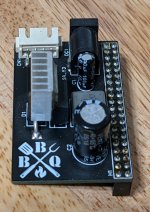I had a need to get this data sent over MQTT. So I spent some time doing more work breaking out the packet from the Meater Block and then relaying it over MQTT. Here is he link to my github project: https://github.com/floyduww/MeaterBlockMQTT . Hope this helps anyone looking more into the breakdown of the packet. Thanks to LKSpencer for the info he provided as I used much of it as a base for my info.
You are using an out of date browser. It may not display this or other websites correctly.
You should upgrade or use an alternative browser.
You should upgrade or use an alternative browser.
Meater wire free probe intergration.
- Thread starter Dean A
- Start date
Javier Bravo
New member
Hello all, i wasn't sure if I should start my own thread or not, but I am working on connecting the MEATER to my RPi3 and i get it to pair for a few seconds then it unpairs and displays the message
'Failed to pair: org.bluez.Error.AuthenticationCanceled'
I am trying to attach a touchscreen interface to the grill to monitor temperatures of the meat inside. I'm relatively new to python and raspberry pi. Any suggestions?
'Failed to pair: org.bluez.Error.AuthenticationCanceled'
I am trying to attach a touchscreen interface to the grill to monitor temperatures of the meat inside. I'm relatively new to python and raspberry pi. Any suggestions?
How did the brisket turn out?I've done a single 1.5 hour cook, smoking a tri-tip and it worked perfectly. My next test will be a full brisket which I have in the fridge and will most likely go on the smoker tomorrow.
LKSpencer
New member
neat! any chance you are going to share your project with the general public? I have an under-utilized meater block.Beautiful. The code did its job perfectly. I went back in my pics and I actually snapped one for that session. I've done several briskets since then and never had any issues.
View attachment 21851
LKSpencer
New member
What I had done previously was to make a pcb that allowed me to feed resistance to my pre-made temperature controller which is a pitmaster iq 110. This fooled the pitmaster iq 110 into thinking that it had a wired probe plugged in to it, when in reality it was just a wire coming from my pi hat.neat! any chance you are going to share your project with the general public? I have an under-utilized meater block.
Since then, I ended up making a new pcb hat for the pi that can directly control the pwm fan I have. The pi hat takes in 12v to power the PWM fan and then drops a line down to 5v to power the pi so you don't need multiple power cables. You would have to build one of those and have a pwm fan, and an attachment to connect that fan up to your smoker. I made it using a pi 4 with 4GB of ram, but I've tested it and primarily use it now with a pi zero w.
I am a software developer by trade but PID tuning is not something I know a lot about. I was able to figure out enough to make it work, but there is definitely room for improvement on the PID tuning side of the code. For example, there is an unaccounted for time difference in my code's reaction to the current circumstances and the natural behavior of smokers rising and falling in temperature. It works well enough for me because I don't constantly open my smoker lid, but for someone that constantly opens the lid to their smoker this could be an issue.
I am not sure it's ready to be shared but I have considered it.
Attachments
So would you consider folding what you do know into HeaterMeter? The proprietary Bluetooth seemed to be a sticking point.What I had done previously was to make a pcb that allowed me to feed resistance to my pre-made temperature controller which is a pitmaster iq 110. This fooled the pitmaster iq 110 into thinking that it had a wired probe plugged in to it, when in reality it was just a wire coming from my pi hat.
Since then, I ended up making a new pcb hat for the pi that can directly control the pwm fan I have. The pi hat takes in 12v to power the PWM fan and then drops a line down to 5v to power the pi so you don't need multiple power cables. You would have to build one of those and have a pwm fan, and an attachment to connect that fan up to your smoker. I made it using a pi 4 with 4GB of ram, but I've tested it and primarily use it now with a pi zero w.
I am a software developer by trade but PID tuning is not something I know a lot about. I was able to figure out enough to make it work, but there is definitely room for improvement on the PID tuning side of the code. For example, there is an unaccounted for time difference in my code's reaction to the current circumstances and the natural behavior of smokers rising and falling in temperature. It works well enough for me because I don't constantly open my smoker lid, but for someone that constantly opens the lid to their smoker this could be an issue.
I am not sure it's ready to be shared but I have considered it.


